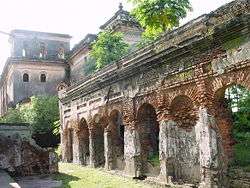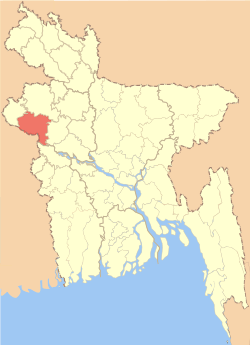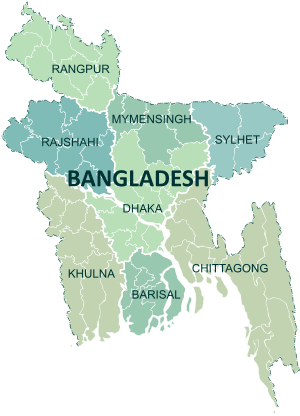Rajshahi District
| Rajshahi District রাজশাহী জেলা | |
|---|---|
| District | |
 Ruins at Puṭhia, Rajshahi | |
 Location of Rajshahi District in Bangladesh | |
| Coordinates: 24°24′N 88°30′E / 24.40°N 88.50°ECoordinates: 24°24′N 88°30′E / 24.40°N 88.50°E | |
| Country |
|
| Division | Rajshahi Division |
| Government | |
| • Jatiyo Shôngshôd Constituencies | Rajshahi-1, Rajshahi-2, Rajshahi-3, Rajshahi-4, Rajshahi-5, Rajshahi-6 |
| Area | |
| • Total | 2,407.01 km2 (929.35 sq mi) |
| Time zone | UTC+6 (BST) |
Rajshahi District (Bengali: রাজশাহী জেলা) is a district in north-western Bangladesh. It is a part of the Rajshahi Division.[1] The metropolitan city of Rajshahi is in Rajshahi District.
History
Rajshahi region was ruled by the Puṭhia Raj family based in the Puṭhia Rajbaɽi. The Mughal Emperror Akbar had given the Rajshahi region to the Puṭhia Raj family to govern, the governor was Pitambar. The Puṭhia family was given the title of Raja by the Mughal Emperor Jahangir.[2] Rajshahi District was established in 1772. Parts of the districts eventually became Bogura district, Malda district, Natore district, Naogaon district, Nawabganj district, and Pabna district. On 1 April 1876 Rajshahi town was made into municipal town. During the Bangladesh Liberation war in 1971 the town was the site of battles between the Mukti Bahini and Pakistan Army. Pakistan Army fought a battle against the Mukti Bahini on 30 March 1971 which resulted in the death of East Pakistan Riles member. Between 26 and 30 March 31 individuals in Godagaɽi upazila were killed by Pakistan Army. On 13 April Pakistan Army killed Rajshahi Cadet College Professor AB Siddiqi. Pakistan Army attacked Tahirpur Haṭ in Bagmara upazila on 24 May and killed 25 people. Mukti Bahini commander Havilder Shafiq led an attack on Pakistan Army boat on 8 August killing 18 Pakistan Army personal. Pakistan Army killed two members of Bangladesh Ansar in war of attrition. Pakistan Army established a camp in the Zoha Hall of Rajshahi University where they massacred hundreds of civilians. Pakistan Army had also established camps inside Rajshahi Cadet College, Roy Saheb brickfield, Sardaha Pilot School, and Sardah Police Academy. The Pakistan Army tortured members of Mukti Bahini and civilians in the camps. The Pakistan Army also killed hundreds of refugees on the banks of Padma river who were fleeing to India. In a fight between Mukti Bahini and Pakistan Army near Kabasmul a Pakistan Army major was killed. Pakistan Army retaliated by killing 44 civilians in Gaganbari and Palsa.[1] The Pakistan Army stationed in Pabna and Rajshahi districts surrendered on 18 December 1971, two days after Pakistani forces in Bangladesh signed the Pakistani instrument of Surrender in Dhaka on 16 December 1971. Pakistani military surrendered to Indian Army Captain Nanda in Naṭore. The Pakistan Army camp in Rajshahi University was taken over by Mukti Bahini members 0n 17 December after fighting them. Surrender ceremonies took place on the 20th December.[3]
Rajshahi town was upgraded to a Municipal Corporation on 13 August 1987. In 1997 the government of Bangladesh made Rajshahi town into a full city corporation, Rajshahi City Corporation.[1] In 2016 Rezaul Karim Siddiquee, a Professor at University of Rajshahi, and a 65 year old Sufi Preacher, Shahidullah, were killed by Islamic extremists.[4]
Geography
Rajshahi district is bounded by Naogaon District to the north, Natore District to the east, and Chapai Nababganj District and the river Padma to the south.
Rivers
There are ten rivers in this district, totaling 146 km in length. The main river is Padma River (Ganges). Some others are Mahananda, Baral and Barnai river.
Demographics
Rajshahi District has a total population of 2,286,874 of whom 1,184,448 are male and 1,102,426 are female. Muslims are 2,136,702; Hindus are 112,643; Buddhists are 22,765; Christians are 599 while 14,165 identify their religion as other. The district has a low literacy rate with average literacy rate of 30.61%. Male literacy is 37.6% while female literacy is 23.2%.[1]
Upazilas
Sub-district or upazilas and thanas of Rajshahi are[1]
- Bagha Upazila
- Bagmara Upazila
- Charghaṭ Upazila
- Durgapur Upazila
- Godagaɽi Upazila
- Mohanpur Upazila
- Paba Upazila
- Puṭhia Upazila
- Tanore Upazila
- Boalia Thana
- Matihar Thana
- Rajpara Thana
- Shah Makdam Thana
Communications
Rajshai district has well organized internal communication as well as connection to other parts of the country. There are 96 metalled roads with a total length of about 1270 km, 108 semi-metalled roads of about 546 km length, and six railways of about 63 km total length.
Economy
Rajshahi Metropolitan is widely known as Silk City of Bangladesh, the Bangladesh Sericulture Development Board (In Bengali : Jatio Resham Board) is situated at Rajshahi. There are seven silk factories in the BSCIC Industrial Town in Rajshahi.[5] Also an Inter-City train is named Silk City express after Rajshahi. The train communicates Rajshahi to Dhaka, the capital city of Bangladesh.[6] Rajshahi is notable in Bangladesh for producing Mango and Silk.[7]
Points of interest
- Puthia Temple Complex
- Tomb of Hazrat Shah Makhdum
- Kismat Madia Mosque
- Bagha Mosque
- Bagdhani Mosque
- Tomb of Hazrat Shah Sultan
- Baɽo Kuṭhi
- Talando Shiv Mandir
See also
References
- 1 2 3 4 5 Mahbubar Rahman, Md. (2012). "Rajshahi District". In Islam, Sirajul; Jamal, Ahmed A. Banglapedia: National Encyclopedia of Bangladesh (Second ed.). Asiatic Society of Bangladesh.
- ↑ "The Royal Palace of Puṭhia". The Daily Star. 2015-11-27. Retrieved 2018-01-07.
- ↑ "Pabna, Rajshahi were freed two days after final victory". The Daily Star. 2013-12-18. Retrieved 2018-01-07.
- ↑ "'Pir' killed in Rajshahi". The Daily Star. 2016-05-08. Retrieved 2018-01-07.
- ↑ "Rajshahi Silk Losing Shine". The Daily Star. 2011-06-13. Retrieved 2018-01-07.
- ↑ "Silk City Express". The Daily Star. 2008-12-26. Retrieved 2018-01-07.
- ↑ "It's mango time in Rajshahi". The Daily Star. 2016-06-21. Retrieved 2018-01-07.
| Wikimedia Commons has media related to Rajshahi District. |
